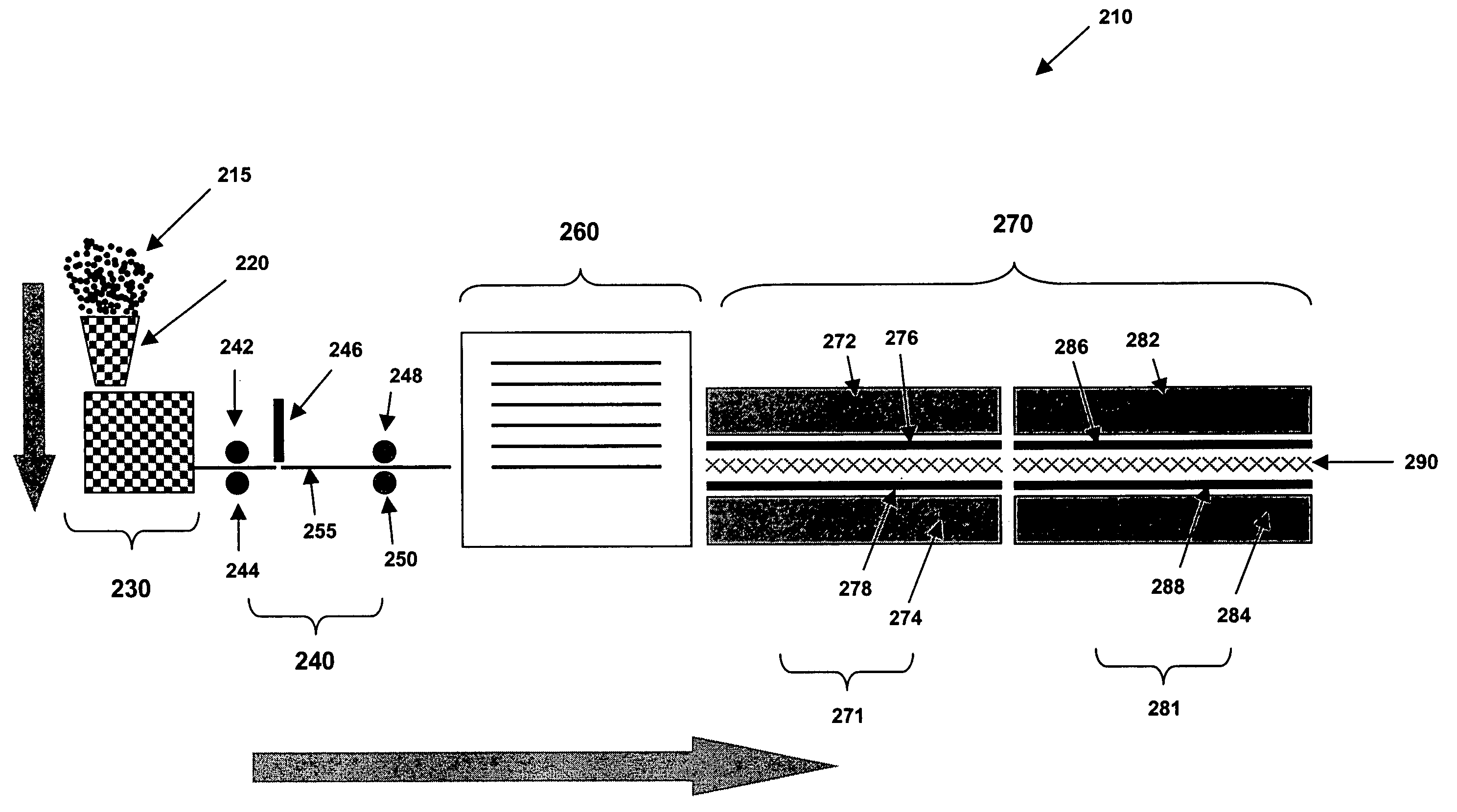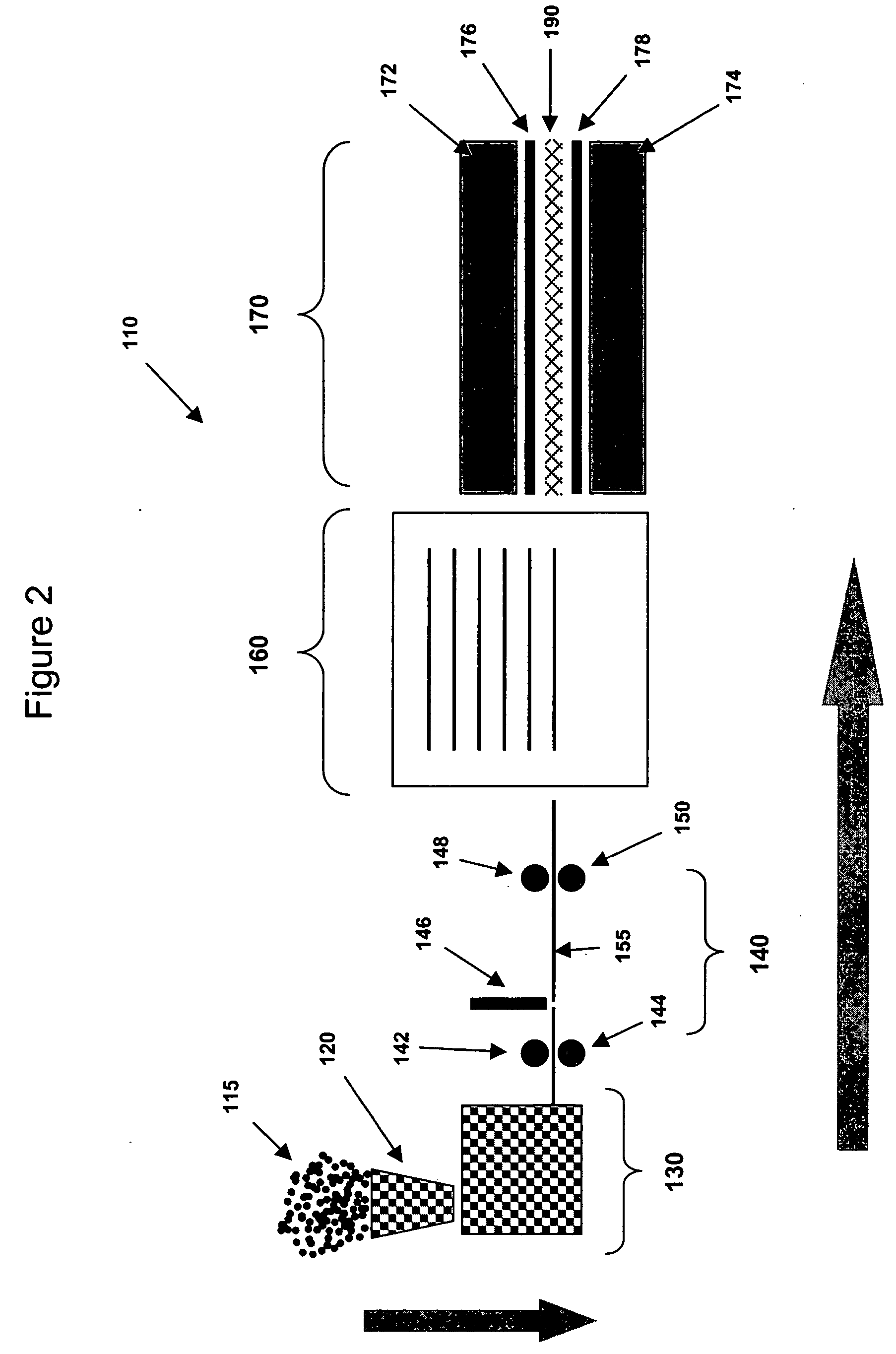Method and apparatus for continuously producing discrete expanded thermoformable materials
- Summary
- Abstract
- Description
- Claims
- Application Information
AI Technical Summary
Benefits of technology
Problems solved by technology
Method used
Image
Examples
first embodiment
[0039] Referring to FIG. 1, the present invention, generally referred to by reference numeral 10, is shown. System 10 has hopper 20, extruder 30, conveyor system 40, and coreformer or expander 70.
[0040] To begin the process of the claimed invention, thermoplastic raw material 15 is loaded into hopper 20. This material is usually in pellet form. Suitable examples of such material include, but are not limited to, high impact polystyrene, polycarbonate, acrylonitrile butadiene styrene, homo or co-polymer polypropylene, low and high density polyethylene and combinations thereof.
[0041] Hopper 20 then feeds the raw material into extruder 30. These materials can be extruded or molded utilizing unfilled polymers, polymer alloys, fiber / filler / nano reinforced polymers, flexible polymers, recycled polymers or combinations of the above. Inside extruder 30, the raw material is heated to a temperature as high as about 300° C., at which point the material becomes a viscous liquid. In this state, ...
second embodiment
[0047] Referring to FIG. 2, the present invention is shown, generally referred to by reference numeral 110. System 110 has hopper 120, extruder 130, conveyor system 140, and coreformer or expander 170, which are identical to the similarly numbered components of system 10 discussed above. System 110 also has buffer loader 160.
[0048] In system 110, the process for creating the thermoformable materials is the same as that of system 10, up until the point at which sheet 155 is loaded into buffer loader 160. Thus, raw materials 115 are fed into hopper 120, which guides material 115 into extruder 130. Extruder 130 forms sheet 155 out of raw materials 115. Sheet 155 is guided through first upper and lower rollers 142 and 144, and then to shear 146, which cuts sheet 155 to a desired length. Sheet 155 is then guided by second upper and lower rollers 148 and 150 to buffer loader 160.
[0049] Buffer loader 160 holds sheet 155 at an elevated temperature while it is waiting to be loaded into core...
third embodiment
[0052] Referring to FIG. 3, the present invention is shown, generally referred to by reference numeral 210. System 210 has hopper 220, extruder 230, conveyor system 240, and buffer loader 260, which are identical to the similarly numbered components of system 110 discussed above. System 210 also has coreformer or expander 270. Coreformer or expander 270 further has heating station 271 and cooling station 281.
[0053] System 210 performs in a substantially similar manner to system 110, with the important exception that there are two separate stages in coreformer or expander 270, as opposed to the coreformers of the above embodiments. Thus, when sheet 255 leaves buffer loader 260, it enters heating station 271 of coreformer or expander 270 first. Heating station 271 has upper heating press 272 and lower heating press 274. Upper and lower heating platen 276 and 278 are operably connected to upper heating press 272 and lower heating press 274 respectively. Upper and lower heating platens ...
PUM
| Property | Measurement | Unit |
|---|---|---|
| Temperature | aaaaa | aaaaa |
| Length | aaaaa | aaaaa |
| Thickness | aaaaa | aaaaa |
Abstract
Description
Claims
Application Information
 Login to View More
Login to View More - R&D
- Intellectual Property
- Life Sciences
- Materials
- Tech Scout
- Unparalleled Data Quality
- Higher Quality Content
- 60% Fewer Hallucinations
Browse by: Latest US Patents, China's latest patents, Technical Efficacy Thesaurus, Application Domain, Technology Topic, Popular Technical Reports.
© 2025 PatSnap. All rights reserved.Legal|Privacy policy|Modern Slavery Act Transparency Statement|Sitemap|About US| Contact US: help@patsnap.com



